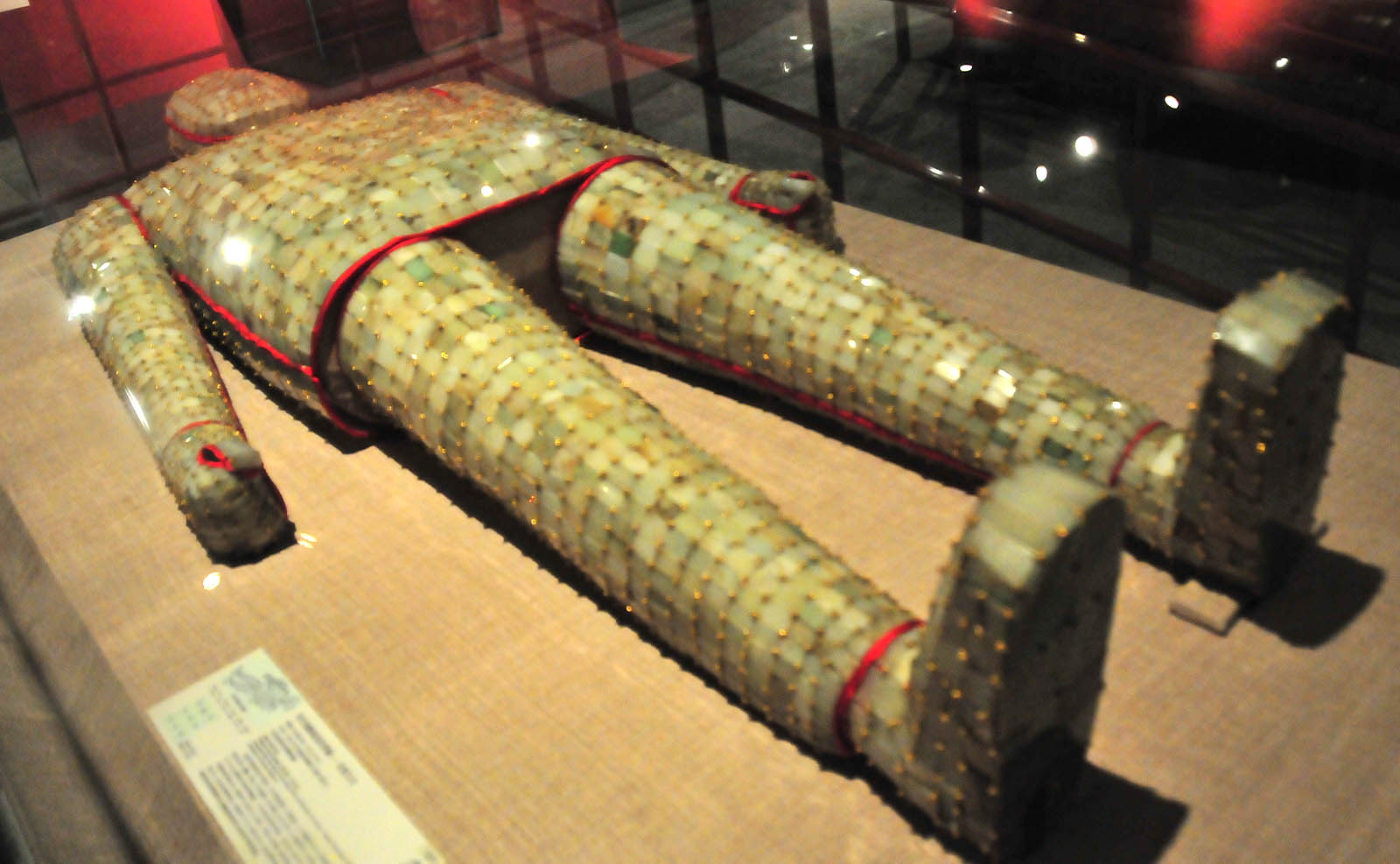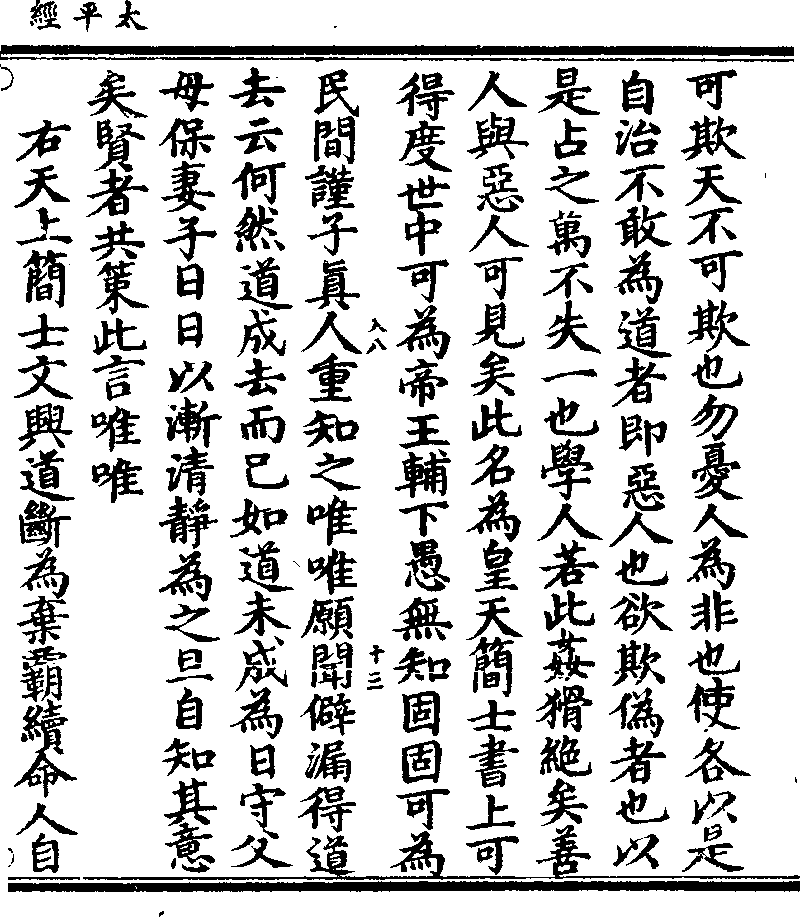|
Internal God
In Taoism, body gods ( zh, p=shēnshén, c=身神), also inner gods or internal gods ( zh, p=nèishén, c=内神) are deities situated within the human body. As many as 36,000 inner gods are described, "who raise the whole body and let it ascend to Heaven." Often they appear as "bureaucrats reporting to the stars." Description The Taoist conception of the body contains a number of "body residents", including gods, hun and po souls, and disease-causing spirits such as the Three Corpses (, ). Meditation can allow the adept to control or manage these entities. The 2nd century describes one such method: There are ten spirits of spring that look like boys dressed in blue; ten spirits of summer that look like boys dressed in red; ten spirits of fall that appear like boys dressed in white; ten spirits of winter that look like boys dressed in black; twelve spirits of the four seasons that seem to be boys dressed in yellow. These are the gods residing in the inner organs of male adepts. ... [...More Info...] [...Related Items...] OR: [Wikipedia] [Google] [Baidu] |
Hun And Po
''Hun'' and ''po'' are types of souls in Chinese philosophy and traditional religion. Within this ancient soul dualism tradition, every living human has both a spiritual, ethereal, yang soul which leaves the body after death, and also a corporeal, substantive, yin soul which remains with the corpse of the deceased. Some controversy exists over the number of souls in a person; for instance, one of the traditions within Daoism proposes a soul structure of (), i.e., "three and seven ". The historian Yü Ying-shih describes and as "two pivotal concepts that have been, and remain today, the key to understanding Chinese views of the human soul and the afterlife". Characters Like many Chinese characters, and are "phono-semantic" or "radical-phonetic" graphs combining a semantic radical showing the rough meaning of the character with a phonetic guide to its former pronunciation in Ancient Chinese. and its variant combine the " ghost radical" , a pictogram origina ... [...More Info...] [...Related Items...] OR: [Wikipedia] [Google] [Baidu] |
Three Corpses
The ''sanshi'' ( zh, c=三尸, tr=Three Corpses, p=sānshī) or ''sanchong'' ( zh, p=sānchóng, c=三蟲, tr=Three Worms) are a Daoist physiological belief that demonic creatures live inside the human body, and they seek to hasten the death of their host. These three supernatural parasites allegedly enter the person at birth, and reside in the three ''dantian'' "energy centers", respectively located within the head, chest, and abdomen. After their human host dies, they are freed from the body and become malevolent ghosts. The pernicious Three Corpses/Worms work to harm their host's health and fate by initiating sicknesses, inviting other disease-causing agents into the body, and reporting their host's transgressions to the gods. The Three Corpses are supposed to keep records of their host's misdeeds, ascend to tian "heaven" bimonthly on the night of Chinese sexagenary while the host is sleeping, and file reports to the who deducts a certain number of days from the person's l ... [...More Info...] [...Related Items...] OR: [Wikipedia] [Google] [Baidu] |
Taipingjing
''Taipingjing'' ("Scriptures of the Great Peace") is the name of several different Taoist texts. At least two works were known by this title: :*, 12 Chapters, contents unknown, author: Gan Zhongke :*, 170 Chapters, only 57 of which survive via the Daozang, author: unknown ''Taipingjing'' usually refers to the work which has been preserved in the Daozang. It is considered to be a valuable resource for researching early Taoist beliefs and the society at the end of the Eastern Han dynasty. Zhang Jue (d. 184), the leader of the Yellow Turban Rebellion, taught "Taiping Taoism" () based on this work. The contents of the ''Taipingjing'' are diverse but it primarily deals with subjects such as heaven and earth, the five elements, yin and yang and the sexagenary cycle. Fundamental concepts in the ''Taipingjing'' The ''Taipingjing'' is a guide that reveals the proper methods to bring forward an era of great peace or equality, the "Great Peace", an idea which probably dates ba ... [...More Info...] [...Related Items...] OR: [Wikipedia] [Google] [Baidu] |
Han Dynasty
The Han dynasty was an Dynasties of China, imperial dynasty of China (202 BC9 AD, 25–220 AD) established by Liu Bang and ruled by the House of Liu. The dynasty was preceded by the short-lived Qin dynasty (221–206 BC) and a warring interregnum known as the Chu–Han Contention (206–202 BC), and it was succeeded by the Three Kingdoms period (220–280 AD). The dynasty was briefly interrupted by the Xin dynasty (9–23 AD) established by the usurping regent Wang Mang, and is thus separated into two periods—the #Western Han (202 BC – 9 AD), Western Han (202 BC9 AD) and the #Eastern Han (25–220 AD), Eastern Han (25–220 AD). Spanning over four centuries, the Han dynasty is considered a Golden ages of China, golden age in Chinese history, and had a permanent impact on Chinese identity in later periods. The majority ethnic group of modern China refer to themselves as the "Han people" or "Han Chinese". The spoken Chinese ... [...More Info...] [...Related Items...] OR: [Wikipedia] [Google] [Baidu] |
Wuxing (Chinese Philosophy)
( zh, c=五行, p=wǔxíng), usually translated as Five Phases or Five Agents, is a fivefold conceptual scheme used in many traditional Chinese fields of study to explain a wide array of phenomena, including terrestrial and celestial relationships, influences, and cycles, that characterise the interactions and relationships within Science and technology in China, science, Traditional Chinese medicine, medicine, Confucianism, politics, Taoism, religion and social relationships and education within Chinese culture. The five agents are traditionally associated with the classical planets Mars, Mercury (planet), Mercury, Jupiter, Venus, Saturn as depicted in the #Etymology, etymological section below. In ancient Chinese astronomy and Chinese astrology, astrology, that spread throughout East Asia, was a reflection of the seven-day planetary order of Fire (wuxing), Fire, Water (wuxing), Water, Wood (wuxing), Wood, Metal (wuxing), Metal, Earth (wuxing), Earth.), they are Wood, Fir ... [...More Info...] [...Related Items...] OR: [Wikipedia] [Google] [Baidu] |
Yellow Court Classic
''The Yellow Court Classic'' (), a Chinese Daoist meditation text,Jing, Anning. "Descent of the holy ancestor: A re-reading of illustration of the classic of the yellow court." ''Orientations (Hong Kong)'' 38, no. 3 (2007): 69-72. was received from an unknown source by Wei Huacun, one of the founders of the Shangqing School (), in 288 CE. The first reference to the text appears in the archives of the famous alchemist and collector of Daoist texts, Ge Hong, in the 4th century. Structure and content The manuscript comprises two parts, the External (Wai, 外) and Internal (Nei, 内) Scenery Scripture. All characters of the shorter (100 verses) text of the External Scripture are fully contained in the longer (435 verses) text of the Internal Scripture. Together, both of the texts are also referred to (within the manuscript itself) as "Jade Book" or "Jade Writing". The fourth century “Sage of Calligraphy”, Wang Xizhi, presented the full text of the Internal Scenery Script ... [...More Info...] [...Related Items...] OR: [Wikipedia] [Google] [Baidu] |
Name
A name is a term used for identification by an external observer. They can identify a class or category of things, or a single thing, either uniquely, or within a given context. The entity identified by a name is called its referent. A personal name identifies, not necessarily uniquely, a ''specific'' individual human. The name of a specific entity is sometimes called a proper name (although that term has a philosophical meaning as well) and is, when consisting of only one word, a proper noun. Other nouns are sometimes called "common names" or (obsolete) "general names". A name can be given to a person, place, or thing; for example, parents can give their child a name or a scientist can give an element a name. Etymology The word ''name'' comes from Old English ''nama''; cognate with Old High German (OHG) ''namo'', Sanskrit (''nāman''), Latin ''Roman naming conventions, nomen'', Greek language, Greek (''onoma''), and Persian language, Persian (''nâm''), from the Proto-In ... [...More Info...] [...Related Items...] OR: [Wikipedia] [Google] [Baidu] |
Daodejing
The ''Tao Te Ching'' () or ''Laozi'' is a Chinese classic text and foundational work of Taoism traditionally credited to the sage Laozi, though the text's authorship and date of composition and compilation are debated. The oldest excavated portion dates to the late 4th century BC. The ''Tao Te Ching'' is central to both philosophical and religious Taoism, and has been highly influential to Chinese philosophy and religious practice in general. It is generally taken as preceding the '' Zhuangzi'', the other core Taoist text.. Terminology originating within the text has been reinterpreted and elaborated upon by Legalist thinkers, Confucianists, and particularly Chinese Buddhists, introduced to China significantly after the initial solidification of Taoist thought. One of the most translated texts in world literature, the text is well known in the West.. Title In English, the title is commonly rendered ''Tao Te Ching'', following the Wade–Giles romanisation, or as ' ... [...More Info...] [...Related Items...] OR: [Wikipedia] [Google] [Baidu] |
Eastern Han
The Han dynasty was an Dynasties of China, imperial dynasty of China (202 BC9 AD, 25–220 AD) established by Liu Bang and ruled by the House of Liu. The dynasty was preceded by the short-lived Qin dynasty (221–206 BC) and a warring interregnum known as the Chu–Han Contention (206–202 BC), and it was succeeded by the Three Kingdoms period (220–280 AD). The dynasty was briefly interrupted by the Xin dynasty (9–23 AD) established by the usurping regent Wang Mang, and is thus separated into two periods—the #Western Han (202 BC – 9 AD), Western Han (202 BC9 AD) and the #Eastern Han (25–220 AD), Eastern Han (25–220 AD). Spanning over four centuries, the Han dynasty is considered a Golden ages of China, golden age in Chinese history, and had a permanent impact on Chinese identity in later periods. The majority ethnic group of modern China refer to themselves as the "Han people" or "Han Chinese". The spoken Chinese ... [...More Info...] [...Related Items...] OR: [Wikipedia] [Google] [Baidu] |
Chinese Theology
Chinese theology, which comes in different interpretations according to the Chinese classics and Chinese folk religion, and specifically Confucian, Taoist, and other philosophical formulations, is fundamentally monistic, that is to say it sees the world and the gods of its phenomena as an organic whole, or cosmos, which continuously emerges from a simple principle. This is expressed by the concept that "all things have one and the same principle" ( zh, p=wànwù yīlǐ, c=萬物一理). This principle is commonly referred to as , a concept generally translated as "Heaven", referring to the northern culmen and starry vault of the skies and its natural laws which regulate earthly phenomena and generate beings as their progenitors. Ancestors are therefore regarded as the equivalent of Heaven within human society, and hence as the means connecting back to Heaven which is the "utmost ancestral father" (). Chinese theology may be also called , a term already in use in the 17th and 18t ... [...More Info...] [...Related Items...] OR: [Wikipedia] [Google] [Baidu] |
Worship Of Heavenly Bodies
The worship of heavenly bodies is the veneration of stars (individually or together as the night sky), the planets, or other astronomical objects as deities, or the association of deities with heavenly bodies. In anthropological literature these systems of practice may be referred to as astral cults. The most notable instances of this are Sun gods and Moon gods in polytheistic systems worldwide. Also notable are the associations of the planets with deities in Sumerian religion, and hence in Babylonian and Greco-Roman religion, viz. Mercury, Venus, Mars, Jupiter, and Saturn. Gods, goddesses, and demons may also be considered personifications of astronomical phenomena such as lunar eclipses, planetary alignments, and apparent interactions of planetary bodies with stars. The Sabians of Harran, a poorly understood pagan religion that existed in Harran during the early Islamic period (7th–10th century), were known for their astral cult. The related term astrolatry usually imp ... [...More Info...] [...Related Items...] OR: [Wikipedia] [Google] [Baidu] |
Ge Hong
Ge Hong (; b. 283 – d. 343 or 364), courtesy name Zhichuan (稚川), was a Chinese linguist, philosopher, physician, politician, and writer during the Eastern Jin dynasty. He was the author of '' Essays on Chinese Characters'', the '' Baopuzi'', the ''Emergency Formulae at an Elbow's Length'', among others. He was the originator of first aid in traditional Chinese medicine and influenced later generations. He also took on the name Baopuzi (), with which translates literally as ‘embracing simplicity’—a reflection of his commitment to fundamental virtues, unadorned truth, and detachment from material temptations. Early life Ge Hong was born near Jurong county in AD 283, as the third son into a well-established family originally from Eastern Wu. His ancestor Ge Xi (葛奚) once served in the high ranking position of Dahonglu (大鸿胪) in Eastern Wu. His great-uncle was Ge Xuan (葛玄) (also known as Ge Xianweng), an alchemist during the Three Kingdoms period. He st ... [...More Info...] [...Related Items...] OR: [Wikipedia] [Google] [Baidu] |






